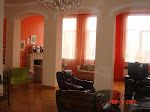



Arajalla Part Two
It is late for me on this Friday night. The trip to the banos (baths) has been completed. These baths in Georgia are both intense and relaxing. The protocol is to sit in a sauna (tonight’s was recorded at 81 degrees Celsius for a while), then a dip in a very cold bath, and then a soak with one’s pores wide open in the mineral springs. This is repeated a number of times with beer and water in between. And for the adventuresome there can be a scrub. I haven’t mustered the courage for this yet as the first part of the scrub looks like torture to me—the guy beats on your back and legs with something that can best be described as karati chops. Then he scrubs your body with an abrasive sponge. Those of you who have been to Turkish baths will, I think, understand. The visit to the banos is cleansing.
But I want to write about the Azeri school. This place reminded me of a school in Israel that I visited outside of Beersheva. It was a place of beautiful children and no books. This Azeris school seems to be a place of no children and no books although I think this impression was created by the time of day that we visisted (early afternoon). Clearly, this Azeri school is a school just plain starved of resources. If there were books, I didn’t see them; if there was technology, I only saw computers which were of little use (a unix operating system and no ed software and no internet connection).
I heard a talk yesterday by a UCLA professor advocating constructivist learning and the virtues of the learning organization. She is here to help train Georgian school principals. The woman principal at this school is in another universe. I wonder if she would like to write a paper for the Women in Educational Leadership journal. That would be an interesting project.
Here is a school for a wide ranging age group—from 1st to 12th grade. How to understand such a place? I showed you a picture of the teachers in the staff room, smiling and welcoming and warming their hands over a leaky wood stove. The students had left for the day and this was early afternoon. I’ve visited other schools in Georgia now and their day seems to stretch into the late afternoon if I am to judge by the kids leaving school on the sidewalks of Tblisi.
Georgia’s educational reforms ring with language about education and democracy and quality. This language attracted me here. Imagine a school system in which children are actually provided with an opportunity to practice democratic citizenship behavior! America's student councils ring hollow compared to the power this national system accords students. But, the ideal appears in many places tp be quite unrelated to reality. . The disconnect between what I saw at Allajara and the reform rhetoric reminds me of the lines from the T.S. Eliot poem, The Hollow Men: Between the idea and the reality, between the motion and the act, falls the shadow. I think I am seeing a shadow realm and I am not at all sure that I will be able to conduct research in this realim.
I doubt not the sincerity of the education ministers and policy makers. But, what an incredible challenge the nation faces in schools like those in Arrajala.
Perhaps one of the measures of the modern schools could be whether or not it attends to the basic needs of children. Is there water? Is there a clean bathroom? Is there heat? Is there adequate lighting? This school had no visible water for kids, a filthy bathroom outside the building (what we in Nebraska would have once called an outhouse), poor heat, and poor lighting. So, I think of Maslow’s hierarchy and realize that the basic elements of need are not addressed in this school.
Pictures attest to this. Here is the outhouse—a hole in the ground that hasn’t been cleaned in years; here is a classroom with a leaky and smoking wood stove; here are the blocks of pressed wood the school orders from the ministry.
On the way out, Rita pointed out to me the red flags on the gates of some of the houses. These flags signify that the household has a 13 year old ready to be married. Guess how many 13 year olds make it to 12th grade in this school? Zero. Do I wonder why all the women teachers in this Azeri school are Gerogian women? Arajalla could use Greg Mortenson or Nicholas Kristof.








Miles... I feel this Arajalla note is one of the most interesting entries in your blog. When reading the conditions of the school, I cannot help thinking schools in some remote rural villages of China, where students and teachers have somewhat similarly poor conditions.
ReplyDeleteOf course, the "hard condition" of a school, like the building, technology and personnel trainings, is crucial. Sometimes, the "soft condition" is also important. I have personally known some people with excellent academic records graduated from schools in extremely poor conditions.
Also, I am wondering if the government has a different policy to treat schools for minority people since this school looks different from other Georgian schools.
Xiao